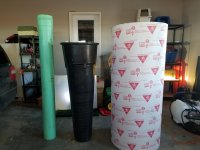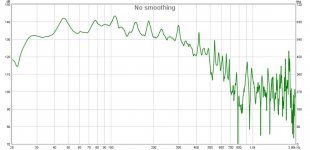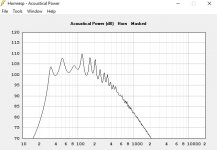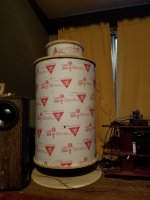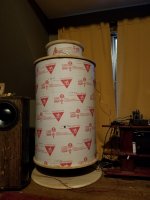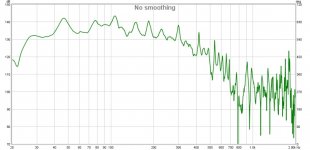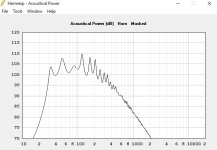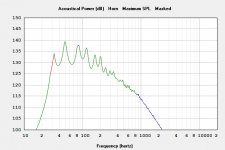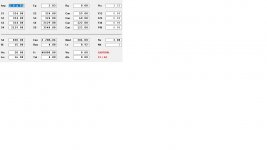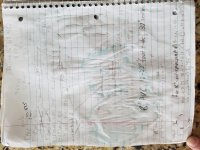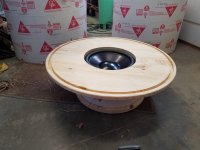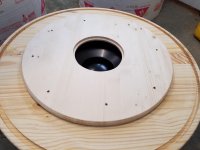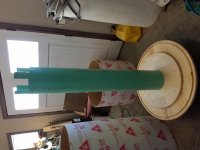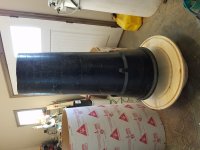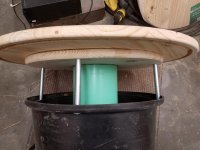I was hesitant to share this until I had a chance to hear and measure it, but I got it hooked up last night and all seems quiet and buzz free. Which surprises me.
I wanted to build a horn sub, but I'm obsessed with finding easier construction methods. I stumbled across a plastic footing form that flares from 10 inches to 22 with 1/8" wall thickness. So I got to work in hornresp modeling every possible configuration. Came up with a decent Sim for an 8" pvc, the flare, and a 30“ concrete form. Nested reentrant style, with pipe and screws to reinforce it all. It's light and easy to build. I'll share the Sim and the measurements when I get home tonight. Hopefully you guys can help me perfect mk2. I know it's massive, but it goes low and is quite sensitive. Craig
I wanted to build a horn sub, but I'm obsessed with finding easier construction methods. I stumbled across a plastic footing form that flares from 10 inches to 22 with 1/8" wall thickness. So I got to work in hornresp modeling every possible configuration. Came up with a decent Sim for an 8" pvc, the flare, and a 30“ concrete form. Nested reentrant style, with pipe and screws to reinforce it all. It's light and easy to build. I'll share the Sim and the measurements when I get home tonight. Hopefully you guys can help me perfect mk2. I know it's massive, but it goes low and is quite sensitive. Craig
Attachments
Cool! Looks like you're on to something since just tubes within tubes makes for a pretty good low tuned TL/high tuned horn.
Wasn't aware of tapered forms even though I've been involved peripherally with concrete plants, construction, etc., most of my life, yet in belated hindsight it seems reasonable they would exist.
GM
Wasn't aware of tapered forms even though I've been involved peripherally with concrete plants, construction, etc., most of my life, yet in belated hindsight it seems reasonable they would exist.
GM
Here is the 2 pi sim and the measured on ground plane at 2m. it was not calibrated spl.
Can anyone tell me why there is so much ripple in the response? I had read that it is caused by refelection back to the cone from the impedence mismatch between the horn mouth and free air, but why is this one affected so badly? I can easily eq it out, but I'd like to understand why it's there. Thanks!
Can anyone tell me why there is so much ripple in the response? I had read that it is caused by refelection back to the cone from the impedence mismatch between the horn mouth and free air, but why is this one affected so badly? I can easily eq it out, but I'd like to understand why it's there. Thanks!
Attachments
picture of it complete, although not cosmetically 🙂
Attachments
Last edited:
Can anyone tell me why there is so much ripple in the response? I had read that it is caused by refelection back to the cone from the impedence mismatch between the horn mouth and free air, but why is this one affected so badly? I can easily eq it out, but I'd like to understand why it's there. Thanks!
Because there's an impedance mismatch at every [poor] termination back to the throat, modulating the driver plus the straight section of pipe adds extra set of harmonic reflections.
GM
Thanks. Would this amount of ripple normally exclude a design as unfavorable? It seems like such a light easy to assemble horn would be a desirable design for certain circumstances.
You're welcome! Depends on room acoustics, etc., plus EQ is the norm in the < 80 Hz BW THX specs, though normally one uses damping at these joints to smooth a lot of this out, ditto around the mouth.
FWIW, the best woofer horn I've auditioned was a '50s era built in mono system 35 Hz BLH where they measured the room, then designed the horn to have peaks where the room dipped and vice versa. Really impressive even in the '60s before digital EQ, delay.
GM
FWIW, the best woofer horn I've auditioned was a '50s era built in mono system 35 Hz BLH where they measured the room, then designed the horn to have peaks where the room dipped and vice versa. Really impressive even in the '60s before digital EQ, delay.
GM
Anyone have any critiques of the design? I added below the input parameters, as well as the 2pi sim and 2pi measurements, also the 1pi sim and the 1pi max output and impulse. Is there anything that could be improved? Seems to me that if you put a couple of wheels on the bottom and a handle on the top, you have a very capable light pa setup. disadvantage is size, but for the max spl capable with only 500W, you'd be less likely to need multiples and huge amps. Any thoughts?
Attachments
Which brand/model driver?
The sim's +/- ~3 dB is normally fine down low, but measures +/- ~ 5 dB, though measured is usually flatter than HR sims, so makes me wonder what I'm missing.
GM
The sim's +/- ~3 dB is normally fine down low, but measures +/- ~ 5 dB, though measured is usually flatter than HR sims, so makes me wonder what I'm missing.
GM
It's the dayton 15“ hf sub driver. I plugged it probably 6 or 8 drivers and it seemed the best fit. My ground plane measurements were only 50 feet from my house. Perhaps that affected the measurements?
Thanks! This one? Dayton Audio RSS390HF-4 15" Reference HF Subwoofer 4 Ohm
Dunno, never done any except at a huge parking lot at least 100 yds away from the plant, though at 50 ft you're ~1130/2/50 = ~11.3 Hz, so wouldn't think so.
GM
Dunno, never done any except at a huge parking lot at least 100 yds away from the plant, though at 50 ft you're ~1130/2/50 = ~11.3 Hz, so wouldn't think so.
GM
That's the one. Thanks for all the help! If anyone is interested in building one let me know and I'll share build pics and sketch with dimensions.
I would be interested! I'm traveling, and not able to build at the moment, but I'd love to see the pics and sketch to understand it a little better.
An externally hosted image should be here but it was not working when we last tested it.
Sorry it looks like a pirate treasure map. It's a little rough but should have the relevant dimensions. Build pics to follow.
My next one will use a 30" plastic cemetube instead of the cardboard cement form. The cement form is very solid. It is not a sonotube brand. I think the plastic would be even more durable and suitable for outdoor applications. I also plan to run the 30" tube all the way to the ground and use a ton of 4" holes to serve as the mouth. That would eliminate the need for the ring 3/4of the way down. If you have the space, you can lay it on its side and face it towards you without the bottom disk. It is a couple dB louder and more impactful like that, just takes up a ton of space. Let me know what's not clear. Craig
Attachments
Last edited:
Start here. This is the top of the sketch. The driver back chamber. 18“ diameter tube 9" tall to recess 1/2“ into the grooves for a final height of 8". Then proceed with the 8"pipe. Securing pipe/ cylinders in grooves with polyurethane construction adhesive. Waiting for each step to set up before proceeding. Be sure to put a 3/4" round over on the corner between the compression chamber and the throat.
Attachments
Sorry for dragging this out, busy lately.
The skinny end of the "foot tube" is cut off to make it 48“ long. End cap on skinny end is fitted and has a groove to accept the 8" pvc "legs".
Then you cut 4 pieces of 1/2" conduit to act as struts to stabilize the foot tube over the pvc. reach inside the foot tube a foot and a half or so and figure out where the conduit pieces will wedge in tight. Then drive a long screw with a washer through the foot tube, the conduit, and into the pvc.... Wish I had a pic for you.
The skinny end of the "foot tube" is cut off to make it 48“ long. End cap on skinny end is fitted and has a groove to accept the 8" pvc "legs".
Then you cut 4 pieces of 1/2" conduit to act as struts to stabilize the foot tube over the pvc. reach inside the foot tube a foot and a half or so and figure out where the conduit pieces will wedge in tight. Then drive a long screw with a washer through the foot tube, the conduit, and into the pvc.... Wish I had a pic for you.
Attachments
Last edited:
Now put 4 more pieces of conduit along the lip of the foot tube with screws and washers.
Attachments
Last edited:
- Status
- Not open for further replies.
- Home
- Loudspeakers
- Subwoofers
- 30 Hz easy to build re-entrant horn
